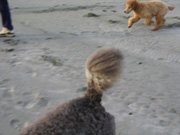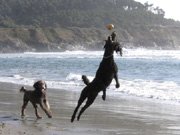Mastering Your Digital Camera
| Resolution Matters Always shoot at your camera's highest resolution. This gives you maximum flexibility for cropping, for making big prints, and for Ken Burns effect in iPhoto and iMovie HD. You can always use iPhoto to make photos smaller (for example, for emailing or Web publishing). Shutter Lag Many digital cameras suffer from a curse called shutter laga delay between the time you press the shutter button and the moment when the shutter actually fires. Shutter lag occurs because the camera's built-in computer must calculate exposure and focus. If you're shooting fast-moving subjects, it's easy to miss the shot you wanted. The solution: give your camera a head start. Press and hold the shutter button partway, and the camera calculates focus and exposure. Now wait until the right moment arrives, then press the button the rest of the way. ISO Speeds In the film world, if you want to take low-light shots, you can buy high-speed filmISO 400 or 800, for example. Fast film allows you to take nighttime or indoor shots without the harsh glare of electronic flash. Digital cameras allow you to adjust light sensitivity on a shot-by-shot basis. Switch the camera into one of its manual-exposure modes (a common mode is labeled P, for program), and then use the camera's menus to adjust its ISO speed. Note that shots photographed at higher ISO speedsparticularly 400 and 800are likely to have digital noise, a slightly grainy appearance. For me, it's a happy trade-off: I'd rather have a sharp, naturally lit photo with some noise than a noise-free but blurry (or flash-lit) photo. Higher ISO speeds can also help you capture fast-moving action by day. The higher speed forces the camera to use a faster shutter speed, thereby minimizing blur. That shot on this page of Mimi leaping into the air? Shot at ISO 400. White Balance Few light sources are pure white; they have a color cast of some kind. Incandescent lamps (light bulbs) cast a yellowish light, while fluorescent light is greenish. Even outdoors, there can be light-source variationsbluish in the morning, reddish in the evening. Each of these light sources has a different color temperature. Our eyes and brains compensate for these variances. Digital cameras try to do so with a feature called automatic white balance, but they aren't always as good at it. That's why many cameras have manual white balance adjustments that essentially let you tell the camera, "Hey, I'm shooting under incandescent (or fluorescent) lights now, so make some adjustments in how you record color." White balance adjustments are usually labeled WB, often with icons representing cloudy skies Sharpness and Color Settings Digital cameras do more than simply capture a scene. They also manipulate the image they capture by applying sharpening and color correction (including white balance adjustments). Some photographers don't like the idea of their cameras making manipulations like these. If you're in this group, consider exploring your camera's menus and tweaking any color and sharpness settings you find. For example, one of my camerasSony's 8-megapixel F828has two color modes: "standard" and "real." The "standard" mode is the default mode, and it punches up the color in a way that I find artificial. One of the first things I did when I got this lovely machine was to switch its color mode to "real." Another of my cameras (I collect them, or so it sometimes seems) is Canon's 5-megapixel S50. It has several sharpening modes, and the default mode is too sharp for my tastes. I took its sharpening mode down a couple of notches. If I feel that an image needs a bit of sharpening, I'll bring it into Photoshop and sharpen it there. Custom White Balance Most cameras also let you create a custom white-balance setting. Generally, the process works like this: put a white sheet of paper in the scene, get up close so the paper fills the viewfinder, and then press a button sequence on the camera. The camera measures the light reflected from the paper, compares it to the camera's built-in definition of white, and then adjusts to compensate for the lighting. If you're a stickler for color and you're shooting under strange lighting conditions, creating a custom white balance setting is a good idea. Better still, shoot in raw mode if your camera allows it. Then you'll have complete control over color balance. Stay Sharp A camera's built-in LCD screen is great for reviewing a shot you just took. But the screen is so tiny that it's often hard to tell whether the photo is in sharp focus. Most cameras allow you to zoom in on a photo while displaying it. I like to zoom in and verify that my photo isn't blurredespecially if the subject is still in front of me and I have another chance. If your camera has an electronic viewfinder, it can be a superior alternative to the LCD screen for reviewing your shots, especially in bright light. Your Camera's Histogram If you read through pages 144 and 145, you've seen the value that a histogram display can offer for making exposure adjustments. Many mid-range and all high-end cameras can display a histogram, too, which you can use to adjust exposure settings before you take a photo. With your camera in one of its manual-exposure modes, activate the histogram display. Then adjust your exposure settingsshutter speed, ISO speed, and apertureso that the histogram's data is as far to the right-hand side of the graph as possible without introducing white clipping. (Remember, white clipping means lost highlight detail.) Photography gurus call this technique exposing to the right, and it ensures that you're getting as much image data as your camera is capable of capturing. Photographer Michael Reichmann, publisher of the magnificent Luminous Landscape site, has written an excellent tutorial on using histograms when shooting. I've linked to it on www.macilife.com/iphoto. Learning More To learn more about digital photography and Photoshop, I heartily recommend Real World Digital Photography by Katrin Eisman, Seán Duggan, and Tim Grey (Peachpit Press, 2004). |

